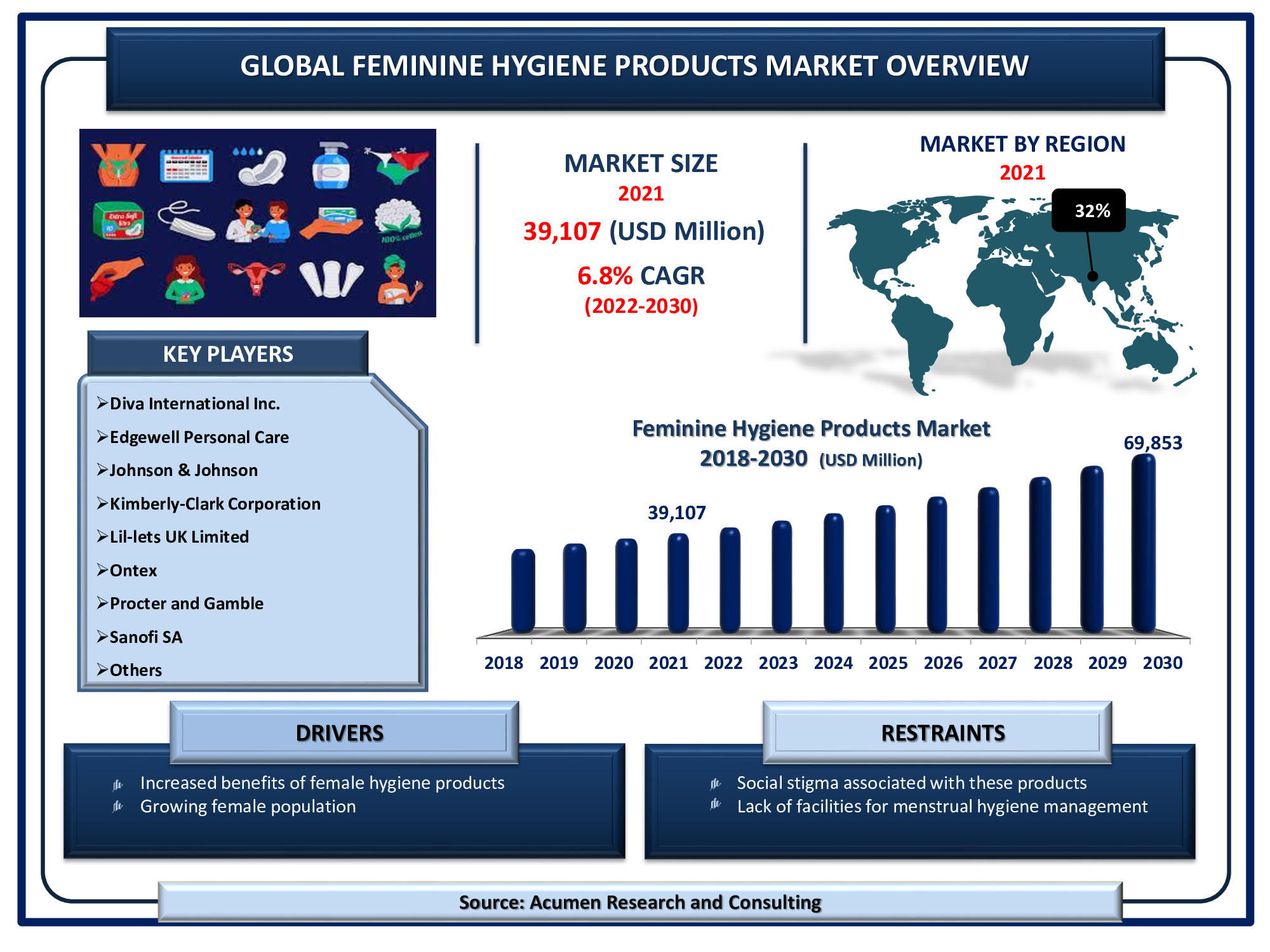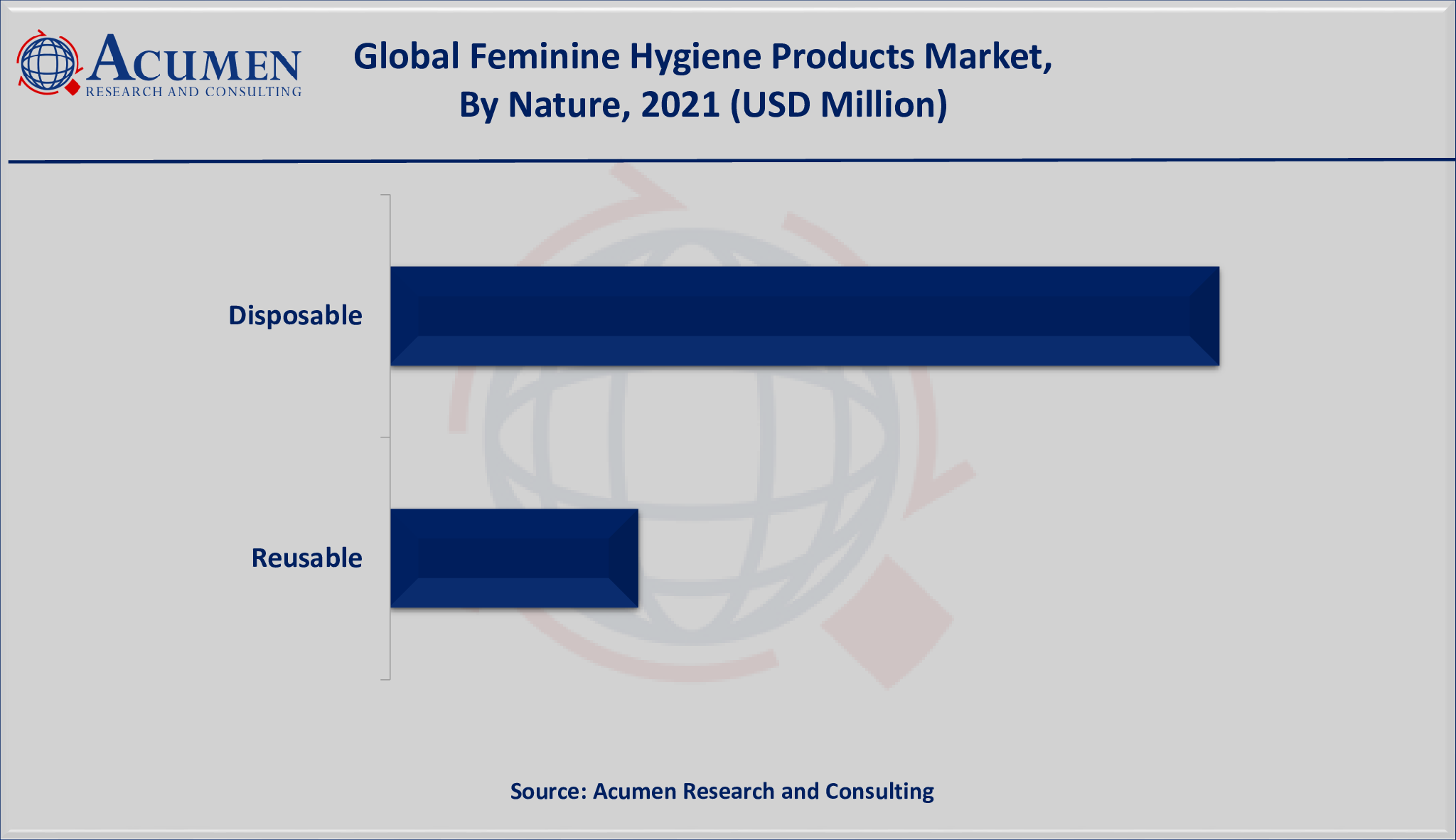September 2022
Feminine Hygiene Products Market is projected to reach a market size of USD 69,853 million by 2030; growing at a CAGR of 6.8%
The Global Feminine Hygiene Products Market Size is valued at USD 39,107 Million in 2021 and is projected to reach a market size of USD 69,853 Million by 2030; growing at a CAGR of 6.8%.

Feminine hygiene products have grown over the years. The increasing awareness regarding women’s hygiene is the primary factor boosting the feminine hygiene products market revenue. According to our feminine hygiene products industry analysis, the growing number of women moving towards cities coupled with the rising number of working women is supporting the market growth. Furthermore, improving policies for women's health is anticipated to boost the industry demand throughout the forecast timeframe from 2022 to 2030.
Global Feminine Hygiene Products Market DRO’s:
Market Drivers:
Market Restraints:
Market Opportunities:
Report Coverage
| Market | Feminine Hygiene Products Market |
| Market Size 2021 | USD 39,107 Million |
| Market Forecast 2030 | USD 69,853 Million |
| CAGR During 2022 - 2030 | 6.8% |
| Analysis Period | 2018 - 2030 |
| Base Year | 2021 |
| Forecast Data | 2022 - 2030 |
| Segments Covered | By Nature, By Product Type, By Distribution Channel, And By Geography |
| Regional Scope | North America, Europe, Asia Pacific, Latin America, and Middle East & Africa |
| Key Companies Profiled | Diva International Inc., Edgewell Personal Care, Johnson & Johnson, Kimberly-Clark Corporation, Lil-lets UK Limited, Ontex, Procter and Gamble, Sanofi SA, Svenska Cellulose Aktiebolaget SCA, and Unicharm Corporation. |
| Report Coverage |
Market Trends, Drivers, Restraints, Competitive Analysis, Player Profiling, Regulation Analysis |
| Customization Scope |
10 hrs of free customization and expert consultation |
The increased value of female hygiene products contributes to the industry's growth in the coming years. The right hygiene products can protect women's clothing and surfaces while also providing them with comfort and confidence. Furthermore, using hygiene products can reduce the risk of infection in women. According to one study, poor feminine hygiene can cause a variety of problems, including urinary tract infections, fungal infections, and even reproductive issues. These medical issues can have an impact on a woman's emotional and mental well-being as well as her physical health. As a result, feminine hygiene products have been outgrown for a couple of years.
The growing female population is another factor boosting the feminine hygiene products market value. According to the United Nations World Population Prospects report, the gender ratio of women is improving day by day, and there are currently more than 3.9 billion (49.5 percent) women in the world. This demonstrates that the global demand for hygiene products is rapidly increasing. On the other hand, the growing female youth population is among the most frequent users of hygiene products, which has fueled the demand at a significant rate.
Rising female literacy rates that result in high product awareness will support the market share for feminine hygiene products. In order to improve the management of women's health, international governmental organizations like UNESCO and UNICEF have been working to increase the literacy rates of young women in low- and middle-income countries. In addition, menstrual health and hygiene are also seen by UNICEF as a fundamental right of women and girls, and as such, it has been identified as a key goal in the organization's Sustainable Development Goals (SDGs) for 2030.
However, the social stigma associated with these products has stifled market growth, particularly in emerging markets. According to WASH United gGmbH, 500 million women and girls do not have the resources they need to manage their periods safely, hygienically, and without embarrassment at any given time. Furthermore, a lack of facilities for women's hygiene management is a factor impeding the market growth. Absenteeism is exacerbated by a lack of infrastructure and stigma; in one Kenyan study, 95 percent of menstruating girls missed 1-3 school days, 70% stated a negative impact on their grades, and more than 50% stated falling behind in class due to menstruation. To combat these occurrences, many public and private organizations, as well as female activists, have led grass-roots initiatives and campaigns, including on social media, to confront stigma, taboos, gender inequality, and period poverty.
Feminine Hygiene Products Market Segmentation
The worldwide feminine hygiene products market is split based on nature, product type, distribution channel, and geography.
Market by Nature

According to our forecast for the feminine hygiene products market, disposable feminine hygiene products held the largest share from 2022 to 2030. The majority of women worldwide prefer disposable hygiene products because they are readily available in retail markets. In addition, disposable female hygiene products provide convenience and a lower upfront cost, which drives industry growth. Reusable feminine hygiene products, on the other hand, are in high demand due to their eco-friendliness, multiple uses, soft fabric, and ability to be customized based on size and flow.
Market by Product Type

Based on our feminine hygiene products industry analysis, sanitary pads commanded the maximum market share in 2021 and are projected to do so during the forecasted period 2022 to 2030. The growing number of working women, increasing health concerns and raising awareness about female hygiene. Besides that, aggressive advertisements, increasing government support, and rising literacy levels are other factors boosting the sanitary pads industry. Conversely, the tampons and menstrual cups segment is anticipated to achieve the fastest growth rate (CAGR) in the coming years.
Market by Distribution Channel
Among all distribution channels, the supermarket/hypermarket gathered a significant market share throughout the forecasted period. Women’s preference to purchase hygiene items from big retail stores is the primary factor driving the segmental growth. Supermarkets and hypermarkets offer the ability to physically check the product and their specification and since women's hygiene products are intimate items they are very conscious when selecting the suitable product. Thus, this segment dominates the market. However, the online channel is likely to attain the fastest growth due to the increasing options for these products on the online channel and increasing social media advertising which also boosts online sales.
Feminine Hygiene Products Market Regional Outlook
North America
Europe
Latin America
Asia-Pacific
The Middle East & Africa (MEA)
The growing population of women’s in Asia-Pacific fuels the regional feminine hygiene products market growth
According to our regional analysis of the feminine hygiene products market, Asia-Pacific is anticipated to hold the largest regional share over the estimated period from 2022 to 2030. The primary factor driving the regional share is the high female population in emerging economies such as China and India. Besides, the rapid urbanization, increasing working women population, rising awareness about personal hygiene, and increased disposable incomes are some of the factors that are boosting the Asia-Pacific feminine hygiene products market revenue.
Furthermore, the North American region will register the fastest growth rate in the coming years. A higher standard of living, higher income levels for women, and better sanitation practices are supporting the North America feminine hygiene products market.
Feminine Hygiene Products Market Players
Some of the top Feminine Hygiene Products companies offered in the professional report include Diva International Inc., Edgewell Personal Care, Johnson & Johnson, Kimberly-Clark Corporation, Lil-lets UK Limited, Ontex, Procter and Gamble, Sanofi SA, Svenska Cellulose Aktiebolaget SCA, and Unicharm Corporation.
Looking for discounts, bulk pricing, or custom solutions? Contact us today at sales@acumenresearchandconsulting.com
September 2022
March 2021
November 2020
July 2021